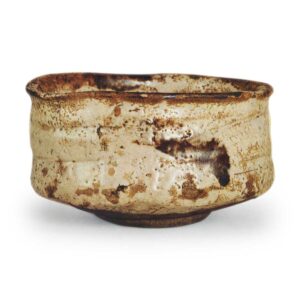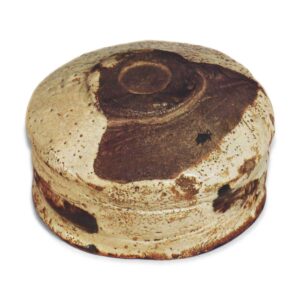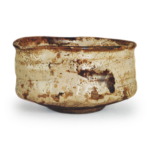

Collection: Tokiwayama Bunko
Height: 7.3-7.7cm
Diameter: 12.6-13.1cm
Outer diameter of foot: 5.9-6.1cm
Height: 0.6cm
The first thing to notice about this tea bowl is the dignified and stately appearance of its shape from the side. The rise from the waist to the rim is almost vertical, and the way the rim curves strongly at the rim is similar to the Asahina yellow Seto ware, and it is full of power and has a high level of refinement.
The body has two levels of scraping marks, which also help to tighten up the overall shape. The mouth is a slightly recessed circle when viewed from directly above, but there are some parts that are strongly distorted, which also bring about unintentional changes. And because the mouth is quite tight, the inside of the bowl has a sense of being much larger and deeper than it actually is.
The foot is unusual for a Shino tea bowl, being a simple, round, carved foot, and there is no hint of artifice, making it plain but pleasing with a sense of tightness.
On one side of the interior, there is a single brushstroke in the shape of a character, and on the two outer sides, there is a single brushstroke each, and a picture that is neither a pattern nor a character, but is like a luxurious design, is drawn. The picture drawn on the demon plate is well blended and changes between light and dark, and it oozes out from under the thick Shino glaze, and is extremely deep in flavor.
The Shino glaze that covers the entire piece is quite thick, and in particular, the bottom has a rather rough craquelure that has formed and thickened, but the color is somewhat pale and yellowish, giving the piece a slightly different feel to other Shino tea bowls.
However, the border between the clay and glaze on the foot ring has the distinctive reddish color of Shino, and there is also a reddish hue around the rim, but it has a rather austere and wabi-sabi feel. There are also traces of glaze flaking and air bubbles here and there on the body, which also give it a faint reddish hue. The clay feels a little more solid than ordinary Shino, but it is the so-called mugusa clay.
This tea bowl is also mentioned in the book “Shino Kiseido Oribe” by Morikawa Jochun, and it was formerly owned by Matsudaira Fumai. On the inside of the lid, there is a gold-powdered inscription that reads “Shino Hatsune Tea Bowl”. The author is not sure, and it is not the so-called Fumai style of calligraphy, but there are some who think it may be Fumai’s handwriting because a similar style of calligraphy can be seen in Fumai’s letters and other documents.
In the “Unshu Meibutsu Ki” (Famous Things of Unshu), there is a record of three Shino tea bowls: “Ume-ga-ka”, “Asahagi”, and an unmarked “Shino”, but the name “Hatsune” does not appear. However, it is known that the tea ceremony using this “Hatsune” was held in the so-called “Dai-en-an Tea Ceremony Record” at the Osaka residence of Lord Fumai. After that, it was passed down from the Matsudaira family to the Nagoya tea master Morikawa Jochuan, and then from the same family to the Sugawara family.








